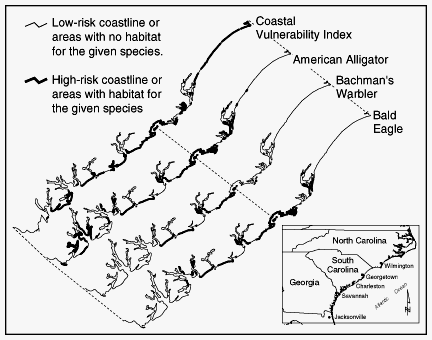


Impact of increased sea levels on coastlines and species habitats in the
U.S. Southeast.

How will high-risk coastlines respond to increases in sea level? How does the loss of land impact coastal development and species habitats?

Areas at risk to increased erosion rates and inundation from sea-level rise in the U.S. Southeast were identified using a coastal hazards database. Approximately 66% of the coastline in the U.S. Southeast is developed, with the remainder being located in or near state and national parks, refuges, and seashores.
Based on the climate change scenarios of the Intergovernmental Panel on Climate Change (1990), nine case studies have been performed for high-risk sections of the coastline. In general these studies found that developed portions of the coast are located on sandy barrier islands or on sandy mainland coasts. These areas will primarily experience increased beach erosion rates because of sea-level rise that will place billions of dollars worth of resort and recreational facilities at risk.
Undeveloped areas tend to consist of coastal wetlands, with most of the undeveloped sandy coasts and barrier islands being protected by federal or state law. The primary threat to coastal wetlands is from inundation. Reduction in the extent of these wetland habitats may have a significant impact on the continued existence of several endangered and threatened species. For example, in South Carolina a rate of sea-level rise of as little as 4.5 mm/year (the current regional rate is 2 to 3 mm/year) would place more than 50% of the bald eagle, Bachman's warbler, red-cockaded woodpecker, and brown pelican habitat at risk to destruction.

Daniels, R. C., T. W. White, and K. K. Chapman. 1993. Sea-level rise: Destruction of threatened and endangered species habitat in South Carolina. Environmental Management 17(3):373-385.
Daniels, R. C., V. M. Gornitz, A. J. Mehta, S.-C. Lee, and R. M. Cushman. 1992. Adapting to Sea-Level Rise in the U.S. Southeast: The Influence of Built Infrastructure and Biophysical Factors on the Inundation of Coastal Areas. ORNL/CDIAC-54. Oak Ridge National Laboratory, Oak Ridge, Tenn.
Integrated Assessment Briefs. 1995. ORNL/M-4227. Oak Ridge National Laboratory, Oak Ridge, TN.